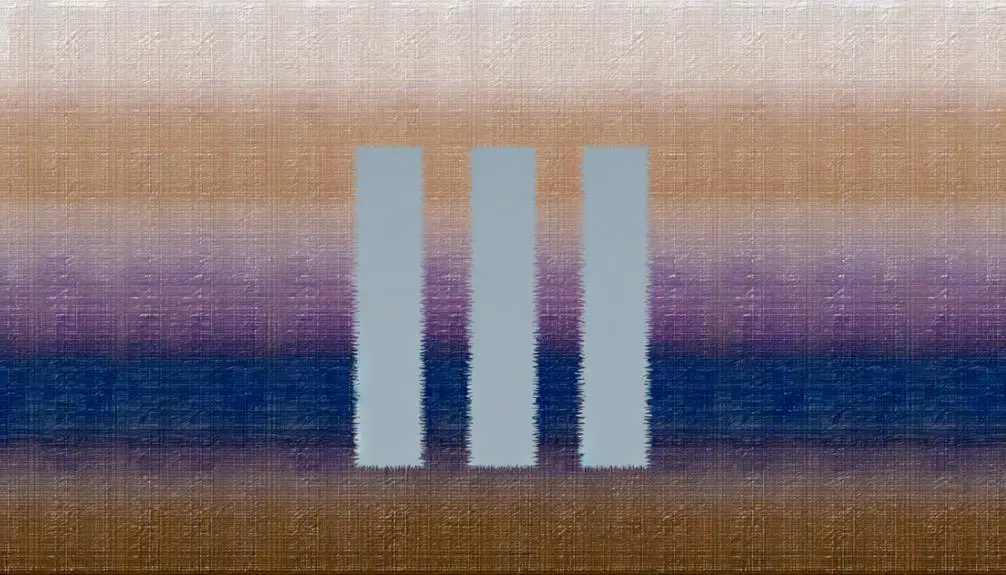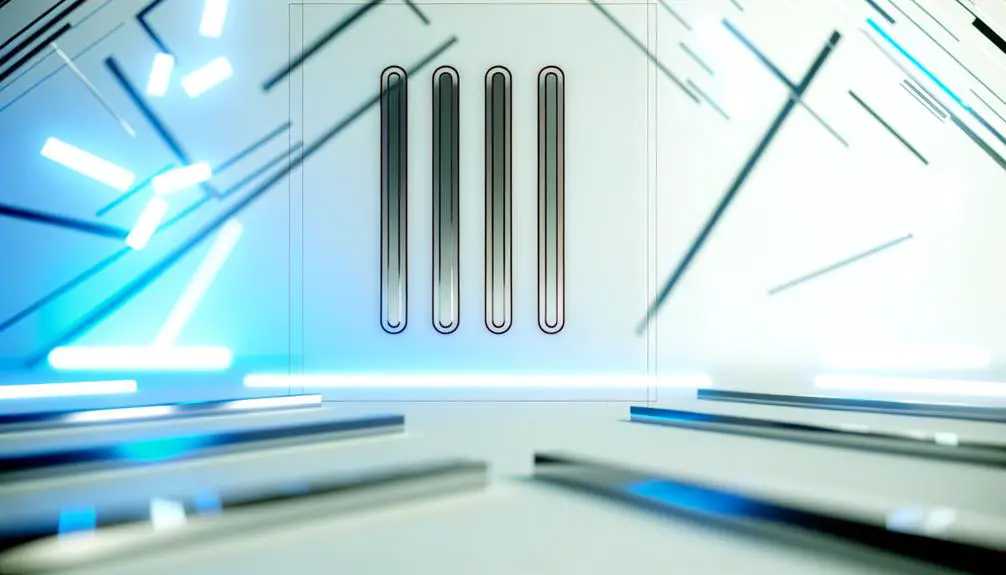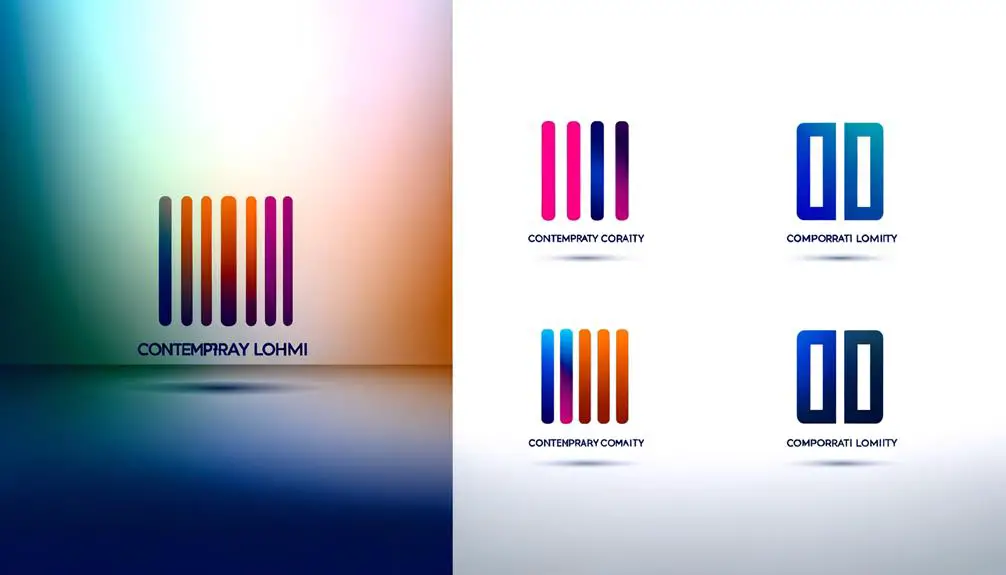How to Interpret the Meaning of the Three Vertical Lines Symbol in Math and Logic
The symbol of three vertical lines is steeped in historical and cultural significance. In ancient civilizations, such as Egypt and Greece, they represented divine authority and a connection to the gods.
In art, vertical lines symbolize strength, stability, and a bridge between heaven and earth. Modern interpretations extend to minimalist design, emphasizing growth, progress, and enhancing visual coherence.
In corporate logos, these lines convey sophistication and authority, while in tattoos, they highlight resilience and personal milestones. This multifaceted symbol invites deeper exploration of its rich meanings across various contexts and eras.

Key Takeaways
- Three vertical lines can symbolize stability, structure, and balance in art and design.
- They often represent a connection between heaven and earth, emphasizing spiritual or divine relationships.
- In modern contexts, they convey growth, progress, and resilience.
- The lines can signify a journey or progression through challenges, marking significant milestones.
- They are used in corporate logos to express authority, sophistication, and modern aesthetics.
Historical Origins

The historical origins of vertical lines as symbols can be traced back to ancient civilizations, where they often represented concepts of stability, strength, and connection between the earthly and the divine.
In ancient Egypt, vertical lines were prominent in hieroglyphics and architectural structures, symbolizing the pharaohs' divine right to rule and their connection to the gods.
Similarly, in Mesopotamian art and cuneiform writing, vertical lines were used to demarcate boundaries and convey authority.
The Greeks and Romans employed vertical columns in their temples, which not only provided structural integrity but also symbolized human aspiration towards higher knowledge and connection with the cosmos.
These historical uses underscore the enduring significance of vertical lines in conveying profound meanings across various ancient societies.
Cultural Significance
The cultural significance of vertical lines spans a rich tapestry of meanings, from ancient symbolism to modern interpretations. These lines have been emblematic in various societies, often representing strength, stability, and connection to the divine, while their contemporary usage encompasses abstract art and design.
In addition, cross-cultural variations highlight the diverse ways in which vertical lines are perceived and integrated into daily life, reflecting unique societal values and historical contexts.
Ancient Symbolism
In ancient civilizations, vertical lines often held profound cultural significance, symbolizing concepts such as power, divinity, and connection between the earthly and the celestial domains. These lines were more than mere geometric figures; they conveyed deep meanings across various cultures.
For instance:
- Egyptian Hieroglyphs: Vertical lines often depicted life force and divine power, aligning with the gods.
- Chinese Symbolism: In traditional Chinese culture, vertical strokes represented stability and the axis mundi connecting heaven and earth.
- Indigenous American Art: Vertical lines symbolized rain, which was crucial for agriculture and survival, thereby embodying life-giving properties.
These interpretations underscore the universal resonance of vertical lines, illustrating their role in conveying essential cultural and spiritual tenets across diverse ancient societies.
Modern Interpretations
Modern interpretations of vertical lines explore their nuanced cultural significance, exploring how they continue to evoke themes of strength, connection, and transcendence in contemporary art, architecture, and design.
In modern art, these lines often symbolize the continuity of human experience and the aspiration towards higher states of being. Architects employ vertical lines to convey structural integrity and elevate aesthetic appeal, manifesting ideals of growth and progress.
Designers utilize vertical lines to create visual harmony and guide the observer's gaze, fostering a sense of direction and purpose. These interpretations reveal a persistent cultural resonance, where the simplicity of vertical forms encapsulates complex human ideals and aspirations, bridging historical contexts with contemporary expressions.
Cross-Cultural Variations
Across various cultures, vertical lines have been imbued with distinct meanings and symbolism, reflecting diverse philosophical, spiritual, and social paradigms.
In Ancient Egypt, three vertical lines often represented pillars of stability and strength, crucial for the pharaoh's afterlife journey.
In East Asian traditions, vertical lines may symbolize the connection between heaven, earth, and humanity, integral to Confucian and Taoist thought.
Meanwhile, in modern Western contexts, these lines can signify growth, progress, and the passage of time.
Each interpretation underscores the profound cultural significance embedded in the simple form of three vertical lines.
Symbolism in Art

In the domain of art, vertical lines have historically signified strength, growth, and stability, attributes that have been deeply embedded in various cultural interpretations over time.
By examining the evolution of these meanings, one can observe how artists have incorporated vertical lines into their design elements to convey specific emotions and narratives.
This interplay between historical usage and contemporary artistic expressions reveals a nuanced understanding of vertical lines within the broader context of visual symbolism.
Historical Symbol Usage
Throughout history, vertical lines have been utilized in art to convey a wide range of symbolic meanings, often representing concepts such as strength, divinity, and the passage of time. This symbolism is evident across various cultures and epochs, manifesting in diverse artistic expressions.
Strength and Stability:
Vertical lines can symbolize pillars or columns, often used in classical architecture to convey robustness and support.
Divinity and Connection:
In religious art, vertical lines frequently represent the connection between the earthly and the divine, as seen in depictions of ascension or divine intervention.
Passage of Time:
Artists use vertical lines to depict time's progression, such as in timelines or tree rings, underscoring the continuity and linearity of existence.
These interpretations enrich our understanding of the profound depth behind such seemingly simple elements.
Cultural Interpretations Evolved
Numerous cultural narratives have continuously reshaped the symbolic interpretation of vertical lines in art, reflecting evolving societal values and philosophical contemplations.
In ancient cultures, vertical lines often symbolized connection between the earthly and the divine, embodying aspirations for spiritual elevation.
During the Renaissance, these lines took on new meanings, signifying order and rationality amid burgeoning humanism.
In modern and contemporary art, vertical lines have been recontextualized to convey themes of fragmentation, identity, and existential inquiry.
This evolution underscores how artists and societies reinterpret fundamental symbols to mirror their internal and external worlds, demonstrating the fluidity of meaning in artistic expression.
Consequently, the three vertical lines continue to serve as a versatile motif, adaptable to diverse cultural and temporal contexts.
Artistic Design Elements
Vertical lines, as fundamental elements in artistic design, possess a profound capacity to imbue artwork with layered symbolic meanings that resonate across various dimensions of human experience. Artists utilize vertical lines to create depth, balance, and a sense of movement within their compositions.
The interpretation of these lines can vary, often encapsulating themes such as:
- Strength and Stability: Vertical lines can evoke feelings of solidity and permanence, often used to represent structures or figures that convey resilience.
- Elevation and Aspiration: These lines may suggest growth or spiritual ascent, symbolizing an upward journey or aspiration toward higher ideals.
- Division and Order: Vertical lines can demarcate spaces, creating a sense of order and segmentation within the artwork, thereby organizing the viewer's perception.
These elements collectively heighten the viewer's engagement and interpretation.
Religious Interpretations
In various religious traditions, vertical lines often symbolize the connection between the divine and the earthly domains, representing a conduit for spiritual communication and enlightenment.
In Christianity, the three vertical lines may be interpreted as a representation of the Holy Trinity—Father, Son, and Holy Spirit—signifying unity and divine presence.
Similarly, in Hinduism, vertical lines are used in tilaka markings, symbolizing divine auspices and spiritual focus.
In Buddhism, vertical lines can denote the path to enlightenment, linking earthly existence to higher states of consciousness.
These interpretations underscore the universal human quest for connection with the transcendent, illustrating how simple geometric forms can bear profound spiritual significance across diverse religious landscapes.
Modern Usage

In contemporary contexts, vertical lines have become integral to digital interfaces, especially as a menu navigation symbol, commonly referred to as the 'hamburger menu.' This usage underscores a broader trend in minimalist design, where simplicity and clarity are paramount.
Analyzing these applications reveals how vertical lines contribute to user experience by streamlining visual elements and enhancing functional aesthetics.
Menu Navigation Symbol
The modern usage of vertical lines as a menu navigation symbol, commonly referred to as the 'hamburger icon,' has become ubiquitous in digital interfaces, streamlining user experience by providing a concise method of accessing hidden menus. Its adoption can be attributed to several key factors:
- Space Efficiency: The icon conserves valuable screen real estate, especially on mobile devices.
- User Familiarity: Widespread usage has ingrained the symbol in user habits, reducing the learning curve.
- Functionality: It offers a clean, unobtrusive way to house multiple navigation options without overwhelming the user.
Minimalist Design Trend
Modern interfaces have embraced minimalist design trends, where vertical lines serve not only as navigation symbols but also as key elements in creating clean, uncluttered digital environments. The strategic use of these lines contributes to a streamlined user experience by guiding the eye and delineating sections without overwhelming the viewer.
This simplicity fosters an intuitive interaction, enhancing usability and accessibility. In the context of web and mobile design, vertical lines often demarcate menus, sidebars, and content divisions, embodying the principle of 'less is more.' Their presence underscores a commitment to aesthetic restraint, reflecting a broader cultural shift towards simplicity and functionality in digital spaces.
Such design choices underscore the importance of clarity and focus in contemporary user interfaces.
Typography and Design
Vertical lines in typography and design serve as powerful visual elements that can guide the reader's eye, create organizational structure, and enhance the overall aesthetic of a layout. Their use in design can be dissected into three primary functions:
- Visual Hierarchy: Vertical lines can help establish a clear hierarchy by delineating sections and sub-sections, making complex information more digestible.
- Alignment and Balance: These lines aid in aligning text and graphic elements, ensuring a balanced and harmonious composition.
- Separation and Division: Vertical lines can act as dividers, creating distinct areas within a design, which is particularly useful in multi-column layouts.
Incorporating vertical lines thoughtfully can greatly improve readability and visual coherence, demonstrating their indispensable role in effective typography and design.
Corporate Logos

Utilizing vertical lines in corporate logos can effectively convey authority, stability, and sophistication, making them a strategic choice for branding.
The simplicity and clarity of vertical lines create a sense of order and reliability, which are critical attributes for corporate identity.
For instance, the three vertical lines in the Adidas logo symbolize performance and endurance, aligning with the brand's athletic ethos.
Similarly, vertical lines can also imply growth and progress, making them ideal for industries such as finance and technology.
Their geometric precision resonates with modern aesthetics, often appealing to a target audience that values innovation and trust.
Essentially, vertical lines in corporate logos are not just design elements but powerful symbols that encapsulate a brand's core values and aspirations.
Tattoos and Body Art
Just as vertical lines in corporate logos can convey authority and stability, their use in tattoos and body art can symbolize strength, resilience, and a connection to personal growth. This symbolism is often nuanced and multifaceted, depending on cultural and personal contexts.
- Strength: Vertical lines can represent the enduring nature of an individual's inner fortitude, reflecting their ability to stand tall against adversity.
- Resilience: These lines may also embody the capacity to recover from challenges, signifying a journey of overcoming obstacles.
- Personal Growth: Ultimately, the progression of vertical lines might illustrate a person's development over time, marking significant life events and milestones.
The simplicity of three vertical lines in tattoos can convey profound meanings, resonating deeply with those who wear them.
Psychological Impact

The psychological impact of vertical lines, whether in art, design, or tattoos, can greatly influence an individual's emotional and cognitive responses, shaping perceptions of structure, stability, and strength.
Vertical lines often evoke a sense of height and grandeur, channeling the mind towards feelings of aspiration and progress.
In interior design, vertical lines can make spaces appear taller, fostering a sense of openness.
In tattoos, they can symbolize resilience and determination, reflecting an individual's personal journey.
Additionally, the repetitiveness and uniformity of three vertical lines can induce a calming effect, promoting feelings of order and harmony.
Understanding these psychological impacts is essential for artists, designers, and individuals who seek to leverage these symbolic meanings in their work or personal expression.
Comparative Analysis
A comparative analysis of vertical lines in various contexts—such as visual art, interior design, and body art—reveals a nuanced spectrum of symbolic meanings and psychological impacts that are deeply influenced by cultural, social, and individual factors.
- Visual Art: Vertical lines often symbolize strength, stability, and growth, frequently used to convey a sense of elevation and aspiration.
- Interior Design: These lines can create the illusion of height in a space, promoting feelings of spaciousness and tranquility.
- Body Art: Vertical lines in tattoos may represent personal milestones or journeys, often interpreted as markers of personal growth and resilience.
This comparative approach highlights how the interpretation of vertical lines is not uniform but varies significantly across different domains of human experience.
Conclusion
The three vertical lines symbol, with its rich historical origins and varied cultural significances, embodies a multifaceted narrative that spans religious, artistic, and modern contexts.
From ancient inscriptions to contemporary corporate logos, it serves as a tribute to the enduring power of simple geometric forms.
What deeper meanings lie hidden within these lines, influencing both collective and individual psyches?
This symbol's persistent presence underscores its profound impact across diverse domains of human experience.






